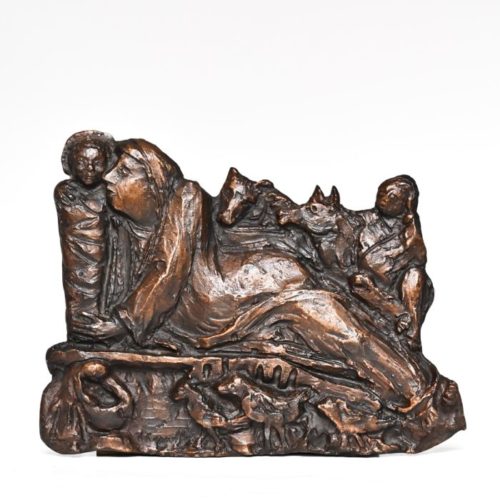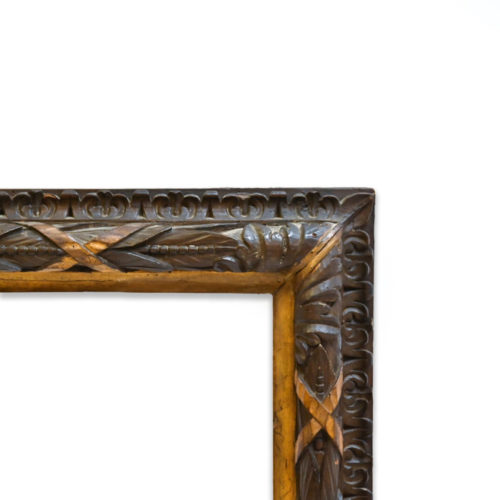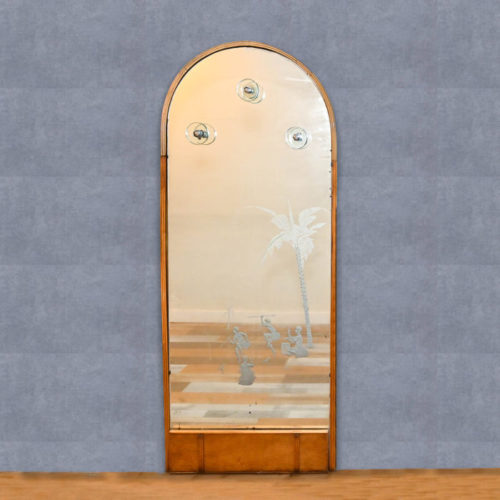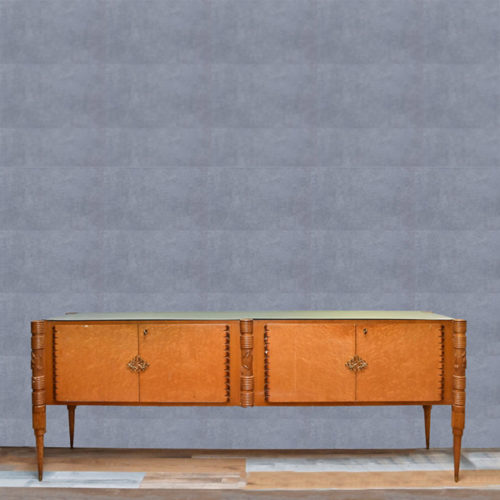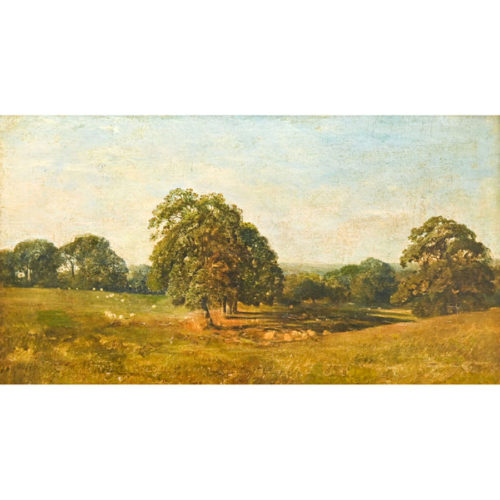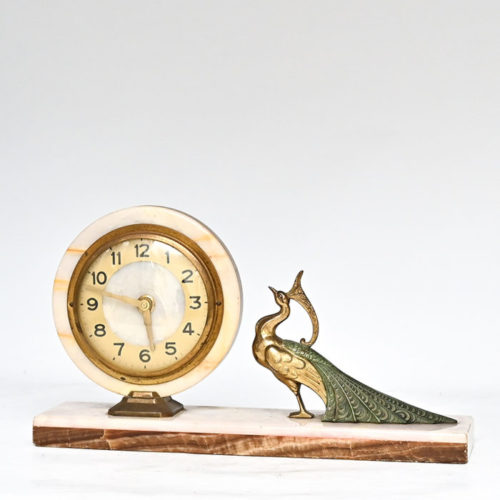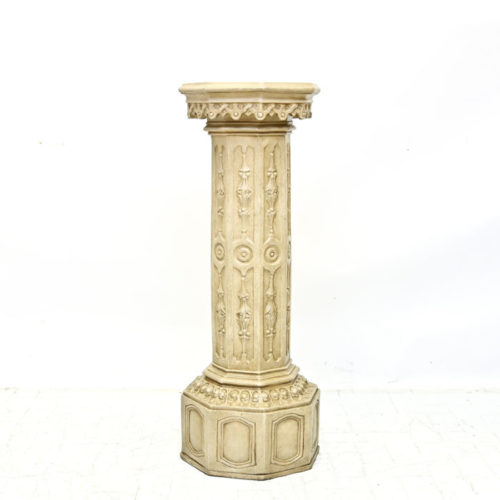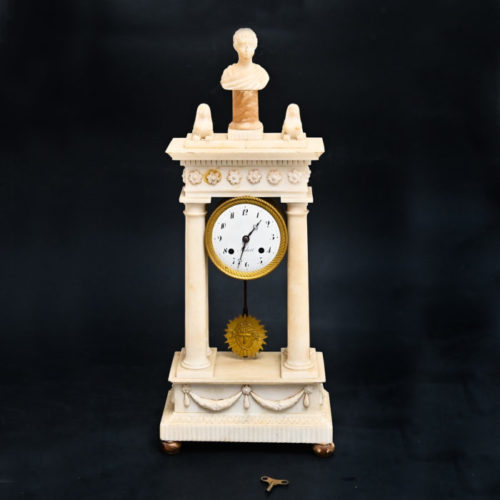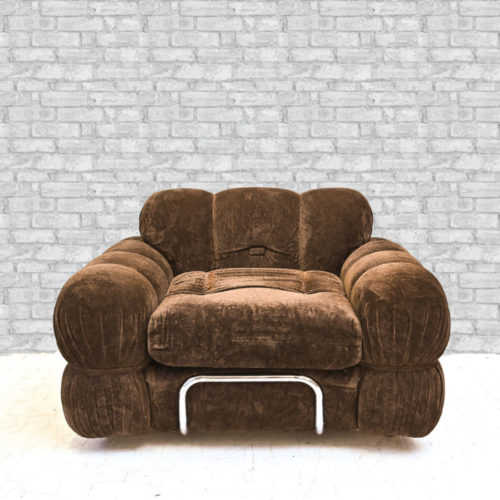-
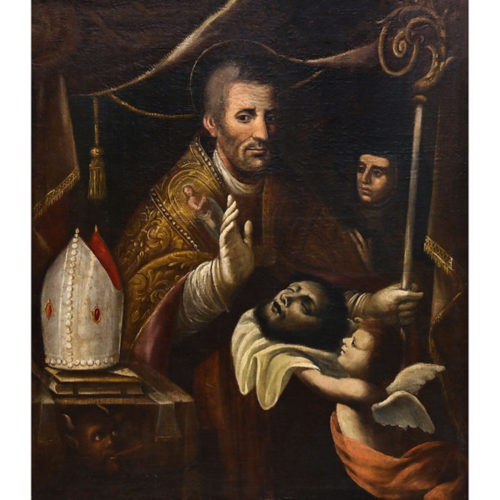 "San Grato Di Aosta with the head of the Baptist" oil on canvas from the first half of the 18th century. The work has been restored. An important legend flourished on the account of San Grato, now proven to be completely anachronistic, which goes by the name of Magna legenda Sancti Grati and is attributed to canon Jacques des Cours, who lived in the 13th century. The story of the discovery of the head of St. John the Baptist, a relic often associated with San Grato in popular iconography, dates back to this tradition. Beheaded by a whim of the beautiful Salome, the head of the Forerunner by order of King Herod Antipas was buried in a well separated from his body, for fear that he might miraculously rejoin it and John might rise again. Grato had a vision from the Lord, in which he was shown the secret location of the burial. He left Aosta in the company of his companion Giocondo, received the Pope's blessing in Rome and then embarked for the Holy Land. During the crossing, a great storm broke out, which threw terror among the sailors, but Grato, raised his arms to the sky, which instantly returned calm. When he arrived in Macheron, near the ruins of Herod's castle, an angel guided him, taking him by the hand and leading him to the well where the head of the Baptist had been for centuries. Immediately the relic rose to the surface and settled in Grato's outstretched palms. Period: First half of the 18th century Measurements: H 110.5 x W 97 x D 2 cm
"San Grato Di Aosta with the head of the Baptist" oil on canvas from the first half of the 18th century. The work has been restored. An important legend flourished on the account of San Grato, now proven to be completely anachronistic, which goes by the name of Magna legenda Sancti Grati and is attributed to canon Jacques des Cours, who lived in the 13th century. The story of the discovery of the head of St. John the Baptist, a relic often associated with San Grato in popular iconography, dates back to this tradition. Beheaded by a whim of the beautiful Salome, the head of the Forerunner by order of King Herod Antipas was buried in a well separated from his body, for fear that he might miraculously rejoin it and John might rise again. Grato had a vision from the Lord, in which he was shown the secret location of the burial. He left Aosta in the company of his companion Giocondo, received the Pope's blessing in Rome and then embarked for the Holy Land. During the crossing, a great storm broke out, which threw terror among the sailors, but Grato, raised his arms to the sky, which instantly returned calm. When he arrived in Macheron, near the ruins of Herod's castle, an angel guided him, taking him by the hand and leading him to the well where the head of the Baptist had been for centuries. Immediately the relic rose to the surface and settled in Grato's outstretched palms. Period: First half of the 18th century Measurements: H 110.5 x W 97 x D 2 cm -
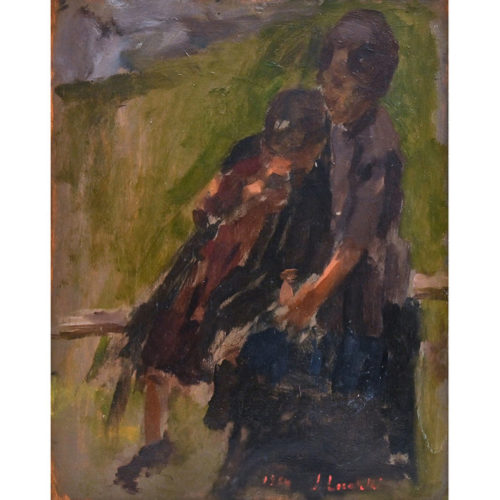 Oil on tablet, Luigi Locatelli. Painted tablet by Luigi Locatelli, depicting mother with child on a fence, signed lower right. No frame. Locatelli Luigi (known as Bigì) (Bergamo 1904-1983) after his first training with his father, he enrolled at the Carrara Academy. Before the age of twenty he starts working for the Milan gallery owner Zecchini. In the 1930s he moved to Paris where he became friends with the great Italian artists who lived in the French capital. After about ten years he returns to Italy settling in Bologna where he works as a restorer. Period: 1934 Measurements: H 41 x L 33 cm
Oil on tablet, Luigi Locatelli. Painted tablet by Luigi Locatelli, depicting mother with child on a fence, signed lower right. No frame. Locatelli Luigi (known as Bigì) (Bergamo 1904-1983) after his first training with his father, he enrolled at the Carrara Academy. Before the age of twenty he starts working for the Milan gallery owner Zecchini. In the 1930s he moved to Paris where he became friends with the great Italian artists who lived in the French capital. After about ten years he returns to Italy settling in Bologna where he works as a restorer. Period: 1934 Measurements: H 41 x L 33 cm -
Out of stock
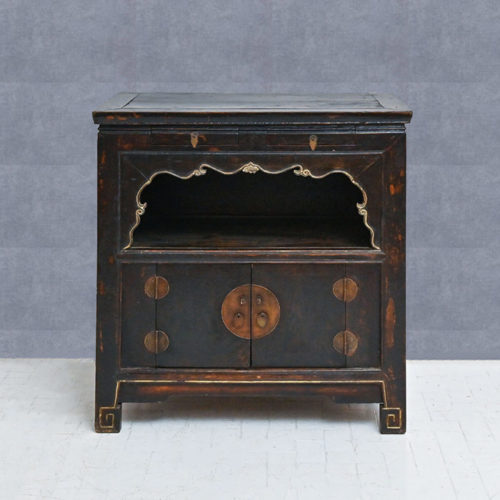 Chinese lacquered cabinet from the 20th century. Furniture made of carved and black lacquered wood, with 2 doors and a day compartment. In excellent condition. Period: 20th century Measurements: H 95.5 x W 88.5 x D 59 cm
Chinese lacquered cabinet from the 20th century. Furniture made of carved and black lacquered wood, with 2 doors and a day compartment. In excellent condition. Period: 20th century Measurements: H 95.5 x W 88.5 x D 59 cm -
Out of stock
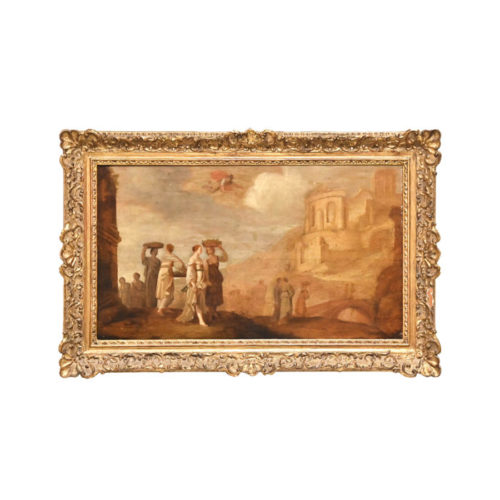 Neoclassical painting, oil on original late 18th century panel, with carved and gilded frame. Period: End of the 18th century Measurements: In frame H 55 x W 84 x D 6 / Table H 39 x L 68 cm
Neoclassical painting, oil on original late 18th century panel, with carved and gilded frame. Period: End of the 18th century Measurements: In frame H 55 x W 84 x D 6 / Table H 39 x L 68 cm -
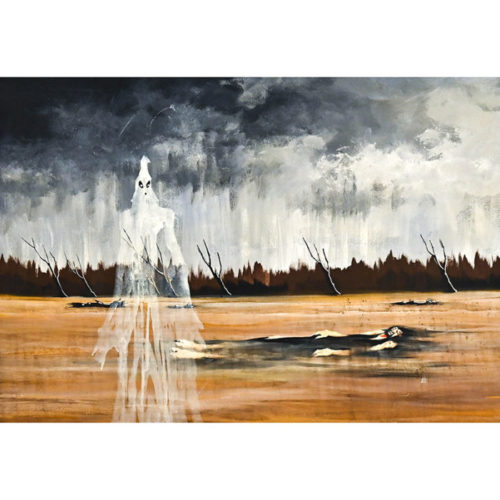 "I am Bonconte da Montefeltro ... So wounded at the top of the throat ..." Oil on canvas by Giancarlo Cori. Painted in 1984, the year in which he paints his last works. Confirmation of authenticity by his son Nicolò Cori. Period: 1984 Measurements: In frame H 84 x W 113.5 x D 3.5 / Canvas H 78 x 107.5 cm
"I am Bonconte da Montefeltro ... So wounded at the top of the throat ..." Oil on canvas by Giancarlo Cori. Painted in 1984, the year in which he paints his last works. Confirmation of authenticity by his son Nicolò Cori. Period: 1984 Measurements: In frame H 84 x W 113.5 x D 3.5 / Canvas H 78 x 107.5 cm -
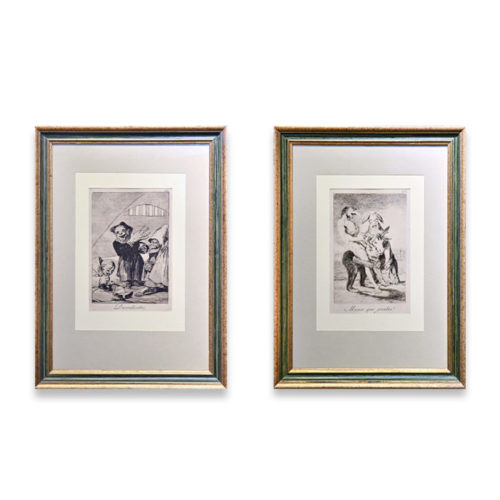 "Duendecitos" etching / aquatint by Francisco Goya y Lucientes (Fuentedos, Spain 1746 - Bordeaux 1828). Original etching - Plate 49 of the "Los caprichos" series - V edition on XII. Bibliography: Harris 84; Delteil 86. Provenance Vianzone, Turin. Dimensions in mm: 190 x 130 "Miren que grabes!" etching / aquatint by Francisco Goya y Lucientes (Fuentedos, Spain 1746 - Bordeaux 1828). Original etching - Plate 63 of the "Los caprichos" series - V edition on XII. Bibliography: Harris 98; Delteil 100. Provenance Vianzone, Turin. Dimensions in mm: 187 x 122 The Capricci represent the most famous series of engravings by the Spanish master: 80 plates including etchings and aquatints of large format, made in 1799. These are plates that give rise to imaginative, pungent and grotesque representations that are affected, on a stylistic level, by an Italian influence due to the long stay in Rome in 1770. The main theme is the description of the evils of the world, from deceptions to prejudices, up to the lies of the Spanish society of the years in which Goya himself lived, in a heated controversy towards the clergy and the nobility. At the time of their publication, the drawings caused a sensation, precisely due to the fact that numerous notables of the time were recognized in them. So much was the clamor that even the Holy Inquisition had to intervene, to avoid the publication of those prints deemed excessive and blasphemous. This was probably what determined the poor success of I Capricci, so that the painter was forced to sell the entire first print run to King Charles IV, in exchange for a scholarship for his son Javier. The success of the series increased with the second edition of 1855, until it became one of the most important and celebrated graphic works in the history of art. Period: Second half of the 19th century Measurements: In frame H 45 x W 33 x D 2.5 cm / H 19 x W 13 cm // In frame H 44 x W 32.5 x D 2.5 cm / H 18.7 x W 12.2 cm
"Duendecitos" etching / aquatint by Francisco Goya y Lucientes (Fuentedos, Spain 1746 - Bordeaux 1828). Original etching - Plate 49 of the "Los caprichos" series - V edition on XII. Bibliography: Harris 84; Delteil 86. Provenance Vianzone, Turin. Dimensions in mm: 190 x 130 "Miren que grabes!" etching / aquatint by Francisco Goya y Lucientes (Fuentedos, Spain 1746 - Bordeaux 1828). Original etching - Plate 63 of the "Los caprichos" series - V edition on XII. Bibliography: Harris 98; Delteil 100. Provenance Vianzone, Turin. Dimensions in mm: 187 x 122 The Capricci represent the most famous series of engravings by the Spanish master: 80 plates including etchings and aquatints of large format, made in 1799. These are plates that give rise to imaginative, pungent and grotesque representations that are affected, on a stylistic level, by an Italian influence due to the long stay in Rome in 1770. The main theme is the description of the evils of the world, from deceptions to prejudices, up to the lies of the Spanish society of the years in which Goya himself lived, in a heated controversy towards the clergy and the nobility. At the time of their publication, the drawings caused a sensation, precisely due to the fact that numerous notables of the time were recognized in them. So much was the clamor that even the Holy Inquisition had to intervene, to avoid the publication of those prints deemed excessive and blasphemous. This was probably what determined the poor success of I Capricci, so that the painter was forced to sell the entire first print run to King Charles IV, in exchange for a scholarship for his son Javier. The success of the series increased with the second edition of 1855, until it became one of the most important and celebrated graphic works in the history of art. Period: Second half of the 19th century Measurements: In frame H 45 x W 33 x D 2.5 cm / H 19 x W 13 cm // In frame H 44 x W 32.5 x D 2.5 cm / H 18.7 x W 12.2 cm -
Out of stock
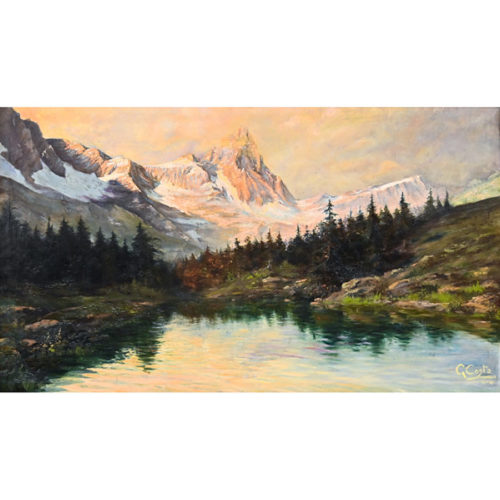 "The Matterhorn with the blue lake" oil on canvas from the early 1920s by Giovanni Battista Costa (Rapallo 1858 - Genoa 1838). The painting has been restored. Giovanni Battista Costa was born in Rapallo in 1858 in a wealthy family and dedicated his entire life to art. He participated, since 1879, in the exhibitions of the Promoting Society of Fine Arts in Genoa and in numerous other important Italian expositions, exhibiting, until 1921, over 100 paintings, mainly landscapes, seascapes and portraits. In 1895 he was appointed Academic of Merit of Ligustica, where he, too, teached. He began his artistic studies at the Ligustica Academy (and partly in Rome), soon going from a painting linked to tradition to the execution of works from life, probably under the guidance of Tammar Luxoro director, from 1874, of the new Landscape School. Consequently, the links with the Genoese Gray School, the Rivara School (in Piedmont) and the Tuscan Macchiaiolo movement appear to be close. The analysis of some of his works lead us to bring Costa closer to some Lombard painters of the 19th century: for example Carcano, especially for the softness of the colours. He takes part in numerous national exhibitions: awarded in 1897 in Venice, he participates in the National Exhibition of Fine Arts in Turin in 1898; in 1906 we find it at the National Exhibition of Fine Arts in Milan; also worth mentioning is his participation in the first Quadrennial Exhibition in Turin in 1902. Giovanni Battista Costa was also a skilled portrait painter and painted in Venice, Parma, Viareggio, Ivrea, Engadina, Valle d’Aosta. Even though he was shy and solitary, he was part of two important schools: the Ligurian Artistic Family (1893 -1910 circa) and the Teatro Group (from 1908); refers to the upper room of the Caffè degli Amici of the Carlo Felice Theater. He is an artist particularly attentive to the social problems of the late nineteenth century. His works appear, in retrospect, in Genoa at the exhibition of Ligurian Painters of the Nineteenth Century (Palazzo Rosso, 1938) and at the Commemorative Exhibition at the San Matteo Gallery, 1952. In his maturity he turned his interest to the representation of mountain landscapes. In conclusion, we can identify three different ways of painting by Costa: the first is related to academic painting, a bit rigid (church interiors and portraiture); the second, realist, with warm colours and close to the themes of the Grays and Rivarians (affinity with Benedetto Musso). Period: 1920s Measurements: In frame H 125 x W 195 x D 6 / Canvas H 101 x W 172 cm
"The Matterhorn with the blue lake" oil on canvas from the early 1920s by Giovanni Battista Costa (Rapallo 1858 - Genoa 1838). The painting has been restored. Giovanni Battista Costa was born in Rapallo in 1858 in a wealthy family and dedicated his entire life to art. He participated, since 1879, in the exhibitions of the Promoting Society of Fine Arts in Genoa and in numerous other important Italian expositions, exhibiting, until 1921, over 100 paintings, mainly landscapes, seascapes and portraits. In 1895 he was appointed Academic of Merit of Ligustica, where he, too, teached. He began his artistic studies at the Ligustica Academy (and partly in Rome), soon going from a painting linked to tradition to the execution of works from life, probably under the guidance of Tammar Luxoro director, from 1874, of the new Landscape School. Consequently, the links with the Genoese Gray School, the Rivara School (in Piedmont) and the Tuscan Macchiaiolo movement appear to be close. The analysis of some of his works lead us to bring Costa closer to some Lombard painters of the 19th century: for example Carcano, especially for the softness of the colours. He takes part in numerous national exhibitions: awarded in 1897 in Venice, he participates in the National Exhibition of Fine Arts in Turin in 1898; in 1906 we find it at the National Exhibition of Fine Arts in Milan; also worth mentioning is his participation in the first Quadrennial Exhibition in Turin in 1902. Giovanni Battista Costa was also a skilled portrait painter and painted in Venice, Parma, Viareggio, Ivrea, Engadina, Valle d’Aosta. Even though he was shy and solitary, he was part of two important schools: the Ligurian Artistic Family (1893 -1910 circa) and the Teatro Group (from 1908); refers to the upper room of the Caffè degli Amici of the Carlo Felice Theater. He is an artist particularly attentive to the social problems of the late nineteenth century. His works appear, in retrospect, in Genoa at the exhibition of Ligurian Painters of the Nineteenth Century (Palazzo Rosso, 1938) and at the Commemorative Exhibition at the San Matteo Gallery, 1952. In his maturity he turned his interest to the representation of mountain landscapes. In conclusion, we can identify three different ways of painting by Costa: the first is related to academic painting, a bit rigid (church interiors and portraiture); the second, realist, with warm colours and close to the themes of the Grays and Rivarians (affinity with Benedetto Musso). Period: 1920s Measurements: In frame H 125 x W 195 x D 6 / Canvas H 101 x W 172 cm -
Out of stock
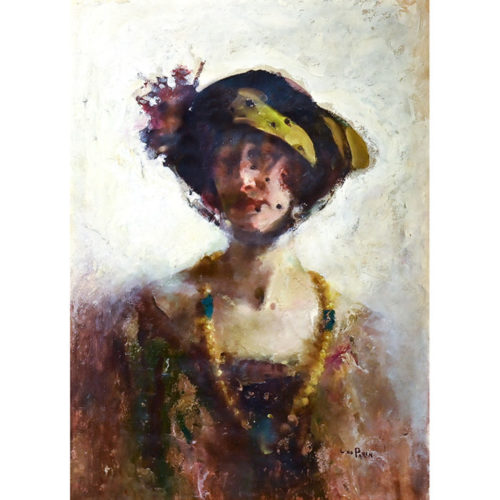 "Woman with veil" oil on paper by Gino Parin. The painting is from the 20s / 30s of the twentieth century, has a beautiful coeval gilded wood frame. The picture and the frame need some cleaning. It comes from a private collection from Biella. Gino Parin was born in Trieste in 1876. His real name was Federico Gino Pollack. He began his artistic education in the studio of the Trieste painter Eugenio Scomparini and then continued at the Venetian Girolamo Navarra's one. At 19 he went to Munich to attend the Academy where he attended the courses of Karl Raupp and became acquainted with the painting of the Pre-Raphaelites, Lenbach, von Marées and von Stuck. Having become a member of the Münchener Künstler Genossenschaft, he often exhibited at the Glaspalast. He traveled extensively in Europe, visiting Switzerland, France and England. From 1910 he began to participate in the collective exhibitions of the Trieste Artistic Circle. Here he settled permanently at the outbreak of the First World War. He participated to the Biennials of 1921, 1924, 1928 and 1932. In 1923 he received the gold medal at the Turin Quadrennial. During this period his style, from the original German academic setting, evolved towards a personal reworking of the taste of the Deco years. His production, mainly focused on female portraits and interior painting, earned him the definition of "painter of beautiful women". Deported by the Germans in 1944, he died in the Bergen Belsen camp. Period: 1920s / 30s Measurements: In frame H 102 x W 82 x D 7.5 / Canvas H 79 x W 59 cm
"Woman with veil" oil on paper by Gino Parin. The painting is from the 20s / 30s of the twentieth century, has a beautiful coeval gilded wood frame. The picture and the frame need some cleaning. It comes from a private collection from Biella. Gino Parin was born in Trieste in 1876. His real name was Federico Gino Pollack. He began his artistic education in the studio of the Trieste painter Eugenio Scomparini and then continued at the Venetian Girolamo Navarra's one. At 19 he went to Munich to attend the Academy where he attended the courses of Karl Raupp and became acquainted with the painting of the Pre-Raphaelites, Lenbach, von Marées and von Stuck. Having become a member of the Münchener Künstler Genossenschaft, he often exhibited at the Glaspalast. He traveled extensively in Europe, visiting Switzerland, France and England. From 1910 he began to participate in the collective exhibitions of the Trieste Artistic Circle. Here he settled permanently at the outbreak of the First World War. He participated to the Biennials of 1921, 1924, 1928 and 1932. In 1923 he received the gold medal at the Turin Quadrennial. During this period his style, from the original German academic setting, evolved towards a personal reworking of the taste of the Deco years. His production, mainly focused on female portraits and interior painting, earned him the definition of "painter of beautiful women". Deported by the Germans in 1944, he died in the Bergen Belsen camp. Period: 1920s / 30s Measurements: In frame H 102 x W 82 x D 7.5 / Canvas H 79 x W 59 cm -
Out of stock
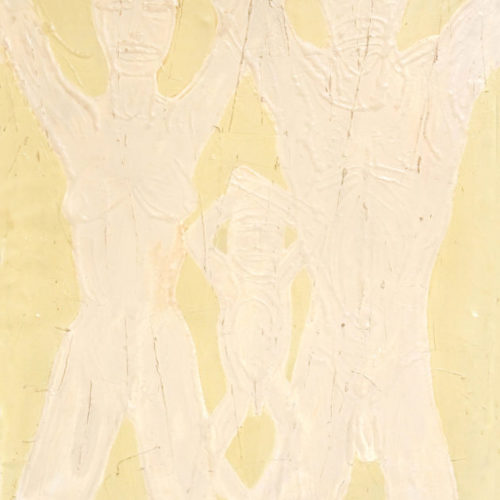 "Primitive family" Oil on canvas by Nik Spatari. Signed on the top right and written on the back "Nik Sparati, Via Solferino 11 Milano". Painting from 1970, taken from the painting exhibited at the 64th Salotto exhibition in 1969. Period: 1970 Measurements: In frame H 124 x W 112 x D 2 / Canvas H 119.5 x W 109 cm
"Primitive family" Oil on canvas by Nik Spatari. Signed on the top right and written on the back "Nik Sparati, Via Solferino 11 Milano". Painting from 1970, taken from the painting exhibited at the 64th Salotto exhibition in 1969. Period: 1970 Measurements: In frame H 124 x W 112 x D 2 / Canvas H 119.5 x W 109 cm -
Out of stock
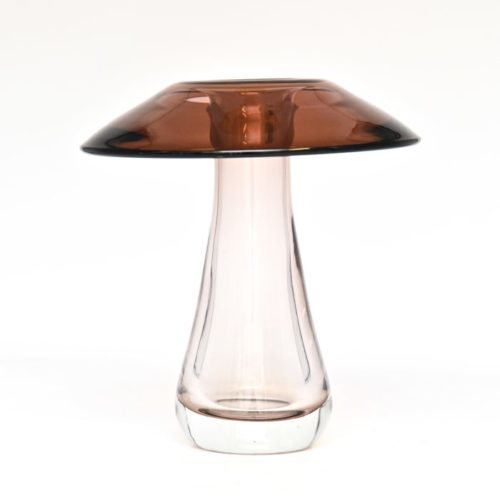 Crystal vase by Antonio Imperatore from the 1980s. This vase was handcrafted in Murano, Italy, by Cristallerie Antonio Imperatore around 1980. It features a clear cylindrical body that gently widens towards its base which represents the "stem" of the mushroom, with a domed upper part in translucent smoked amber glass with a circular hole in the center. In excellent condition. Period: 1980s Measurements: H 28 x Ø 27 cm
Crystal vase by Antonio Imperatore from the 1980s. This vase was handcrafted in Murano, Italy, by Cristallerie Antonio Imperatore around 1980. It features a clear cylindrical body that gently widens towards its base which represents the "stem" of the mushroom, with a domed upper part in translucent smoked amber glass with a circular hole in the center. In excellent condition. Period: 1980s Measurements: H 28 x Ø 27 cm -
Out of stock
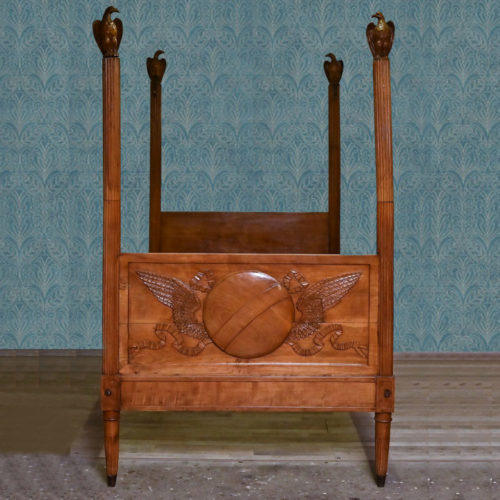 Empire canopy bed in walnut, of French origin. The bed dates from the early 19th century and has columnar uprights and carved eagles. In excellent condition, missing the iron crossbeam, bedstead and mattress. Period: Early 19th century Measurements: H 218 x W 210 x D 130 cm
Empire canopy bed in walnut, of French origin. The bed dates from the early 19th century and has columnar uprights and carved eagles. In excellent condition, missing the iron crossbeam, bedstead and mattress. Period: Early 19th century Measurements: H 218 x W 210 x D 130 cm -
Out of stock
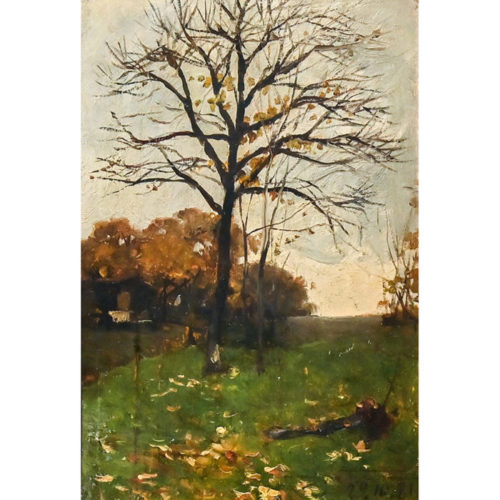 "Last Leaves" oil on panel by Lorenzo Delleani, 25 x 37.3 cm; signed and dedicated: Delleani - to dear brother-in-law Baglioni Giuseppe. Dated 29/10/81. Signed and dated lower right. Private property Biella. Formerly S. Colongo, Biella. Described on page 128 of "Delleani, La vita, l'opera e il suo tempo" by Angelo Dragone. Period: 29/10/81 Measurements: Framed H 57 x W 45 x D 4,5 / Tablet H 37,3 x W 25 cm
"Last Leaves" oil on panel by Lorenzo Delleani, 25 x 37.3 cm; signed and dedicated: Delleani - to dear brother-in-law Baglioni Giuseppe. Dated 29/10/81. Signed and dated lower right. Private property Biella. Formerly S. Colongo, Biella. Described on page 128 of "Delleani, La vita, l'opera e il suo tempo" by Angelo Dragone. Period: 29/10/81 Measurements: Framed H 57 x W 45 x D 4,5 / Tablet H 37,3 x W 25 cm -
Out of stock
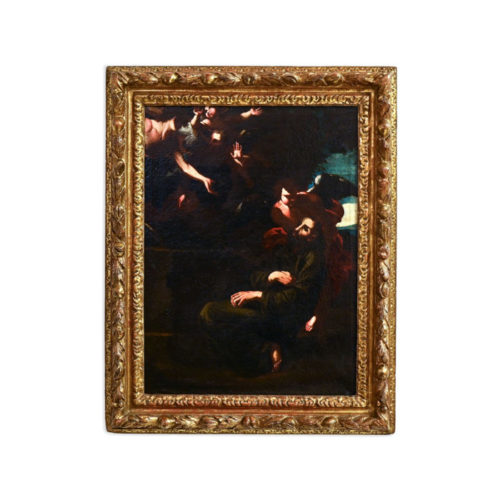 "Ecstasy of St. Francis" oil on canvas from the 17th century, in a coeval frame. Work in excellent condition. The scene of the painting refers to the famous episode in the life of Saint Francis that took place on the Verna mountain in the summer of 1224, when the Saint received the stigmata. Period: 17th century Measurements: Framed H 84.5 x W 66.5 x D 4.5 cm / Canvas H 68 x W 51 cm
"Ecstasy of St. Francis" oil on canvas from the 17th century, in a coeval frame. Work in excellent condition. The scene of the painting refers to the famous episode in the life of Saint Francis that took place on the Verna mountain in the summer of 1224, when the Saint received the stigmata. Period: 17th century Measurements: Framed H 84.5 x W 66.5 x D 4.5 cm / Canvas H 68 x W 51 cm -
Out of stock
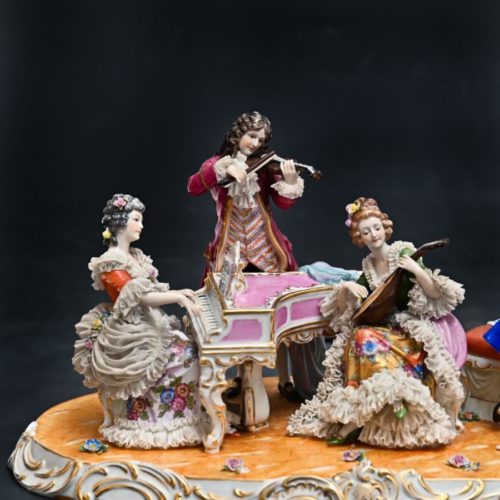 Large porcelain group from Capodimonte, early 20th century, depicting a scene in 18th century dress. Period: Early 20th Century Measurements: H 23,5 x W 48 x D 28 cm
Large porcelain group from Capodimonte, early 20th century, depicting a scene in 18th century dress. Period: Early 20th Century Measurements: H 23,5 x W 48 x D 28 cm -
 Scene of a courtyard, oil on cardboard by Daniele Fissore, signed and dated on lower right, a very rare work as the artist usually depicts the landscape without figures. Daniele Fissore (Savigliano 1947 - Savigliano 2017) began his artistic career as self-taught artist. In 1975 he took part in the X Quadriennale in Rome and in 1976 in the "Biennale del disegno" in Milan. A constant evolution of the first pictorial themes (see the "Telephone booths", the "Oppositions", the "Reconnaissance", investigated with an in-depth analysis of strong photographic inspiration), led him to the human figure and the portrait. Period: 1980 Measurements: Framed H 69 x W 93 x D 4,5 / Cardboard H 60 x W 84 cm
Scene of a courtyard, oil on cardboard by Daniele Fissore, signed and dated on lower right, a very rare work as the artist usually depicts the landscape without figures. Daniele Fissore (Savigliano 1947 - Savigliano 2017) began his artistic career as self-taught artist. In 1975 he took part in the X Quadriennale in Rome and in 1976 in the "Biennale del disegno" in Milan. A constant evolution of the first pictorial themes (see the "Telephone booths", the "Oppositions", the "Reconnaissance", investigated with an in-depth analysis of strong photographic inspiration), led him to the human figure and the portrait. Period: 1980 Measurements: Framed H 69 x W 93 x D 4,5 / Cardboard H 60 x W 84 cm
